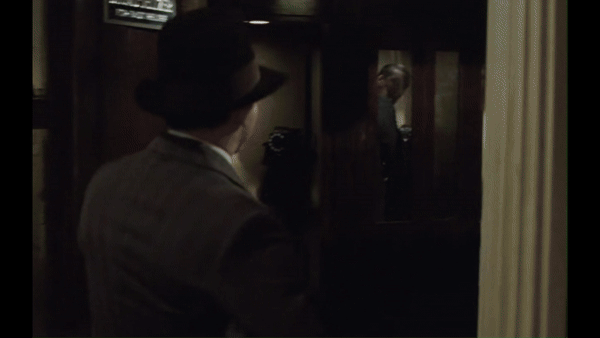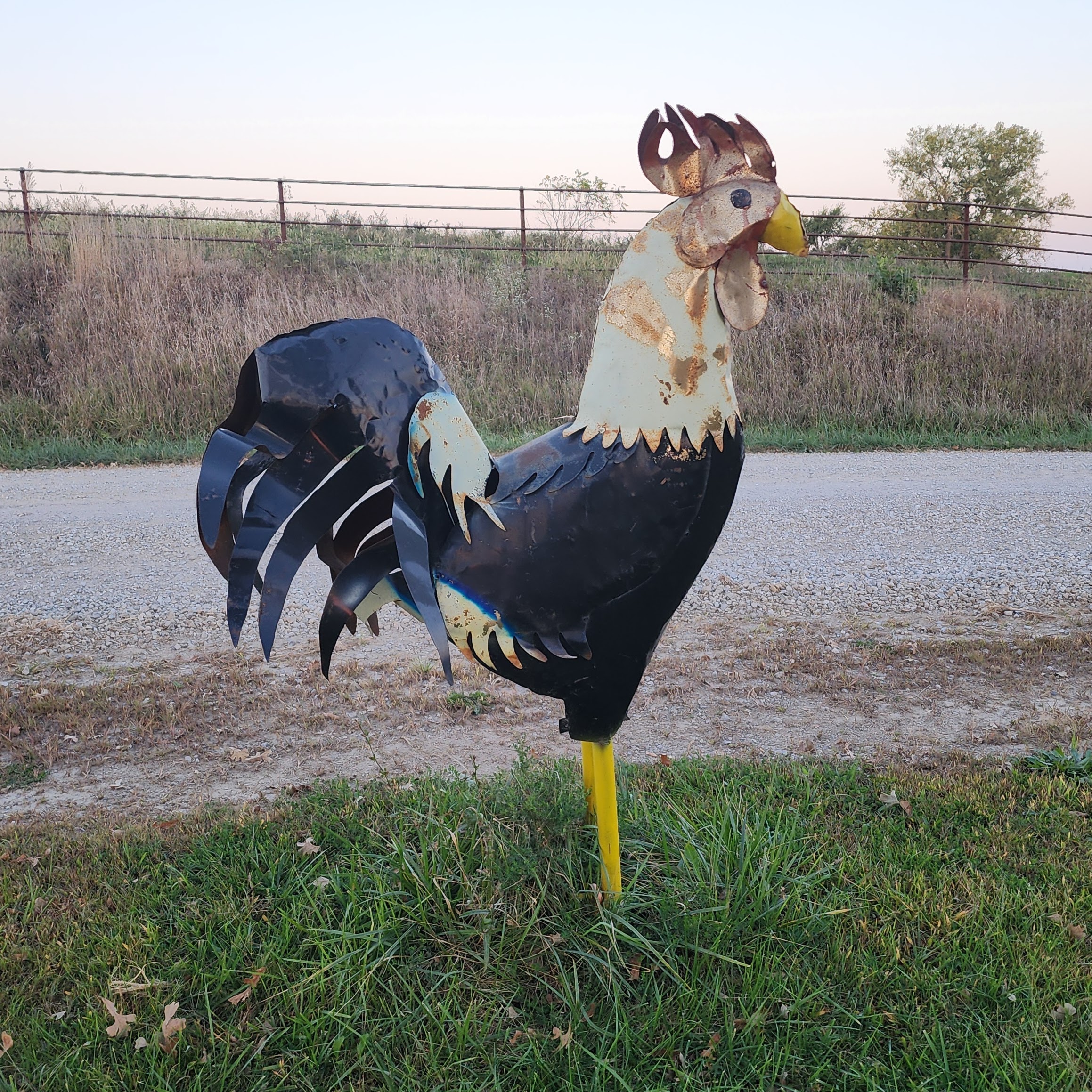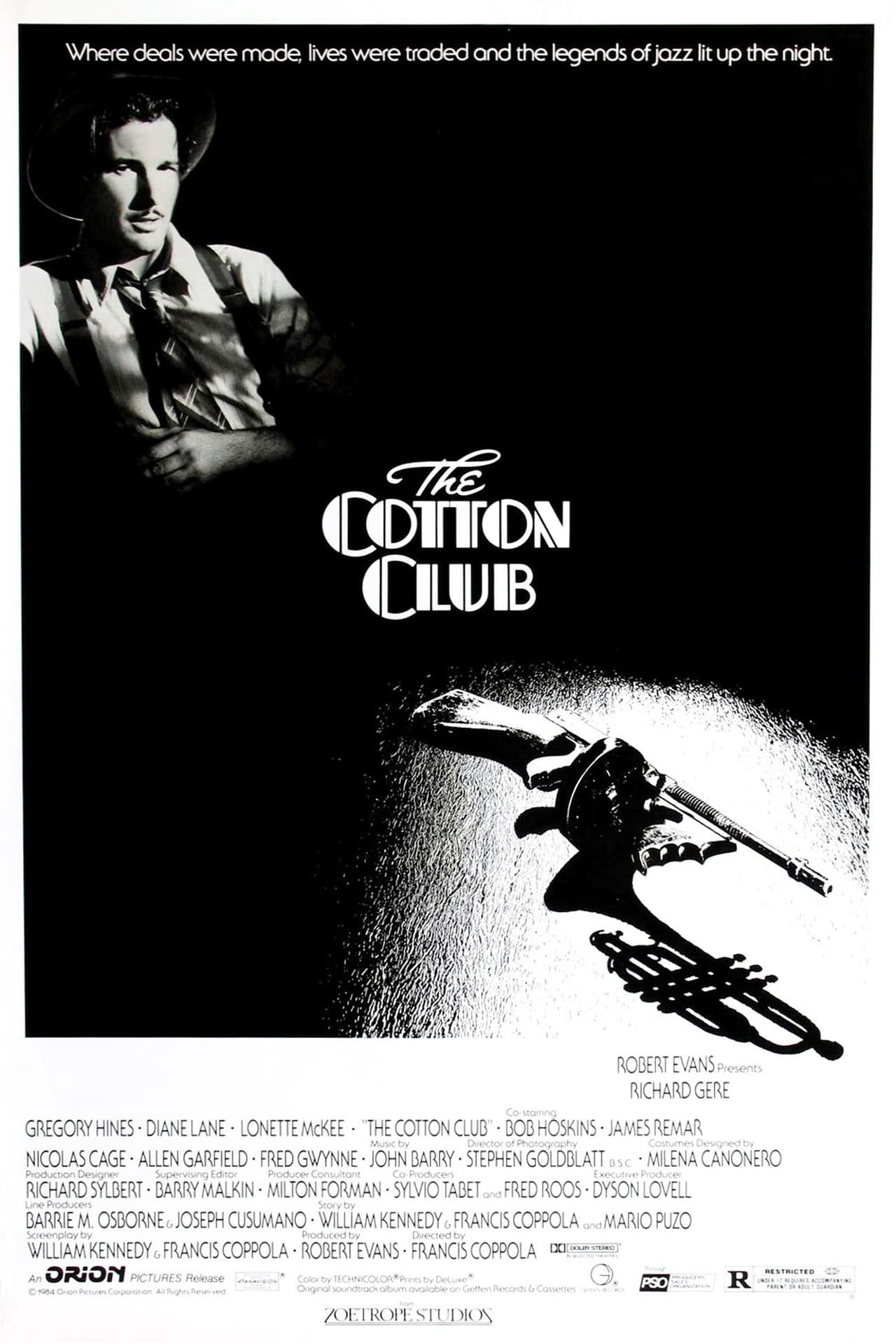What’s this all about?
Francis Ford Coppola’s back with another tale of gangsters. It’s almost like he stumbled into success with The Godfather, then spent the rest of his career trying to recapture that success. Anyway, this one is set in the late 1920’s and nominally tells the tale of two entertainers; one, “Dixie” Dwyer (Richard Gere) is a white coronet piano player, and the other, “Sandman” Williams (Gregory Hines) is a black tap dancer. The former gets unwittingly tied up in the mob life, while the latter does basically nothing at all.
Who is Nick in this one?
Nicolas plays Vincent Dwyer, “Dixie” Dwyer’s younger, punk-ier brother.
Who else is in this one?
As usual, we get Diane Lane, who seems to have aged from about 16 to 25 in the year between this and Rumble Fish. She plays a cardboard cutout mobster love interest who gives the boys something to fight over. As usual, she’s fine, but the role was a total waste of talent.
Speaking of wasted talent, this film is chock full of great stars in bit parts. We get Lawrence Fishburne as the hilariously-named “Bumpy Rhodes”. The inimitable Jackée Harry, as a nameless singer. Don’t blink or you’ll miss Mario Van Peebles as “singer” and Giancarlo Esposito, as “Bumpy Hood”. Sadly, they’re all pretty much just hanging around with nothing to do.
Jennifer Grey plays Vincent’s (Cage) wife. She’s in two scenes in which she just gets shoved out of the way. Francis Ford Coppola put baby in a corner.
Bob Hoskins (Eddie from Who Framed Roger Rabbit) and Fred Gwynne (Herman Munster) are featured, and frankly, I think I would have loved a full film about these two running a crime syndicate together. They’re both master actors, and it shows.
Sofia Coppola is in this, because of course she is.
Did you see that?
There’s a throwaway scene in which Bob Hoskins and Fred Gwynne talk about business while using the urinals. It’s perhaps the most realistic dialog that Francis Ford Coppola ever shot. The camera angles play off of the height difference between the two (Hoskins was 5’4” and Gwynne was 6’5”), and it feels exactly like a thousand similar conversations that I’ve had in real life.
The many Coppola films that I have had to watch as part of this marathon have been filled with stilted, borderline nonsense dialog (“Stay golden, Pony Boy”). Here, we learn that he can do scenes in which humans interact like humans, He just chooses not to. -Michael
One of the highlights of the film for me was the 5 minutes that Jackée Harry sang and danced an act about her no good man and how she was through with him. It was full of all the sass Jackée is known for. – Sarah
What were Nick’s best parts?
During his rise in the organized crime organization, Nick’s character becomes hired muscle for “Dutchman” Dutch Whatever. The Dutchman executes a scheme to fix the Thanksgiving draw on the Harlem numbers racket, thereby bankrupting the black numbers runners. As the numbers runners realize their fate, and seemingly agree that they have no options beyond selling out to “The Dutchman,” our boy Nick kicks open the door to their bar/office, and yells something completely incomprehensible, before unloading a Tommy gun into a room full of people, but hitting no one.
I’ve always said, “If you need someone to scream both frantically and incoherently, Nicolas Cage is your man.” I stand by that. – Michael
I thought Nic did an exceptional job dying in this film. It was every bit as crazy and spastic as his character was. Plus, as an added bonus, he got to do the entire bit confined in a phone booth. – Sarah

What were Nick’s worst parts?
There’s a scene in which Nick has “gone bad” and kidnapped Fred Gwynne (as if!). He negotiates the ransom, and gets payment from Richard Gere. For some reason, Cage plays the whole scene with his face half-covered in shaving cream, and acts like he’s not really paying attention to the conversation. I realize that we’re supposed to think that he was interrupted during shaving, and that this conversation was too important to wait, but he scheduled the ransom exchange, and Richard Gere had to go through a sentry to get in. It felt like Nick was just waiting around like that all day so that he’d look cool.
Also, Richard Gere asks several seemingly direct questions, like, “what are you doing with all of these guns?” Nick never answers, and really just acts disinterested in the whole affair.
For the record, what he was doing with all of those guns was getting murdered in a phone booth. -Michael
For my money, Nic’s worst scene was when Dixie Dwyer took his family out to dinner at the Cotton Club. He had no lines and was barely on camera. – Sarah
How was the movie?
As usual, I think Coppola’s reach exceeded his grasp. There is a lot of story building done to establish the parallels between “Dixie” (Gere) and “Sandman” (Hines), and their lives. Unfortunately, they’re too parallel, in that they never intersect. The Gere storyline is a bog-standard mobster story. The Hines story is completely irrelevant. Literally none of it matters, and if it were removed from the film entirely, about three minutes of rewrite would make it seamless.
I feel like Coppola was trying to say something about crime and race and jazz (maybe?) but really, he just tells two boring stories.
The acting in The Cotton Club was honestly pretty good. As mentioned, a lot of great talent was underutilized.
The cars, outfits, and locations look amazing. I can’t imagine how difficult shooting a period-correct street scene from 1928 must have been.
It’s worth noting that there are several great musical performances in this non-musical film, but the juxtaposition between “real” performers (all of the great black singers and dancers at the Cotton Club) and the actors faking it (Gere and Lane) just seems weird, and cheapens the impact of the real performances. -Michael
I couldn’t agree more. There were too many storylines that went nowhere and seemed pointless in the end. But there were many great numbers that I thoroughly enjoyed watching. – Sarah
Yeah, but did you like it?
Not really. Dick Tracy was a more compelling crime film, and I’ve never enjoyed/understood tap dancing. There are a hundred better crime films and a hundred better musical performance films out there. Go watch Reservoir Dogs, but pause between scenes and watch a scene from The Blues Brothers. You’ll get a more cohesive plot than you’ll get with The Cotton Club.
During this Nicolas Cage movie marathon, we’ve watched some movies so bad that I can’t quit thinking about how bad they were (I’m looking at you, Rumble Fish). To be clear, this isn’t one of those. I won’t watch this one again, and if somebody told me that they loved The Cotton ClubI wouldn’t think that they were a tasteless idiot, but it isn’t very good, either. -Michael
It was okay, but mostly for the music and dance numbers. I was entertained well enough, although I won’t be watching it again and wouldn’t recommend it. – Sarah
Where can I watch it?
Stream it with a subscription to Hulu.


Leave a Reply